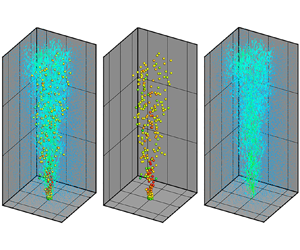Article contents
Experimental study of turbulent bubbly jet. Part 1. Simultaneous measurement of three-dimensional velocity fields of bubbles and water
Published online by Cambridge University Press: 04 May 2022
Abstract

This study proposes a method for simultaneous measurements of time-resolved three-dimensional velocity fields of the dispersed and continuous phases of a turbulent bubbly jet at a low void fraction using Lagrangian particle tracking (LPT) velocimetry with the Shake-The-Box algorithm. Four high-speed cameras are used to acquire time series of images that include both bubbles and fluid tracer particles. Bubbles are firstly tracked using intensity differences between tracer particles and bubbles, then the bubble images are removed from the camera images and all tracer particles are tracked using the residual images. Subsequently, FlowFit interpolation is applied to the LPT results obtained by phase separation to investigate flow characteristics of a bubbly jet. The bubbly jet was divided into two regions along the vertical direction: jet-like and plume-like regions. Streamwise vortex structures of continuous phase were generated mainly by the rising bubbles. The Gaussian and top-hat velocity profiles matched well with the ensemble-averaged fluid and bubble velocities, respectively. The measured slip velocity in the radial direction was not constant but linearly increased. The classical assumption of self-similarity with Gaussian profiles for fluid velocity and bubble concentration is experimentally verified. The fluid volume flux and entrainment coefficient are obtained as a function of the slip velocity, void fraction, plume and bubble width based on three-dimensional measurements. We found that the classical integral theory agrees well with experiments in the plume region.
- Type
- JFM Papers
- Information
- Copyright
- © The Author(s), 2022. Published by Cambridge University Press
References
REFERENCES
- 9
- Cited by



